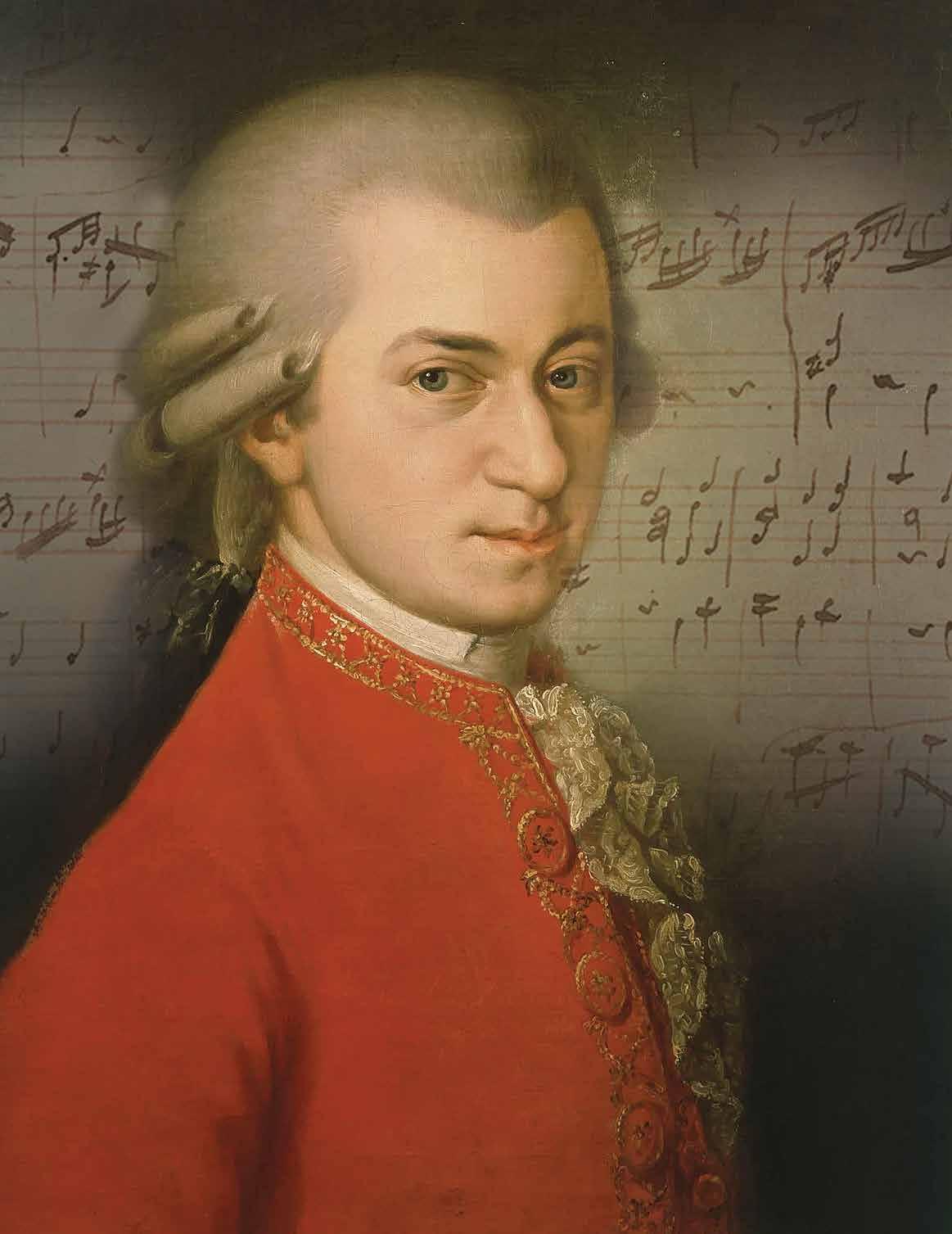
Mu Phi Epsilon International Professional Fraternity for the Advancement of
VOLUME 117 I ISSUE 1 I SPRING 2023
Music in the Community, Nation and World.
MYSTERY MozartUNRAVELING A
16
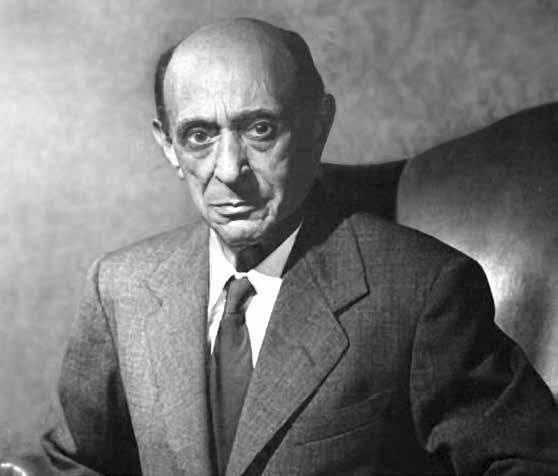
Fraternity Mission Statement:
Mu Phi Epsilon International Professional Music Fraternity is a coeducational fraternity whose aim is the advancement of music in the community, nation and world through the promotion of musicianship, scholarship and music education with emphasis on service through music.
EDITOR Kat Braz editor@muphiepsilon.org
DESIGN & PRODUCTION Paul Wilson thetriangle@muphiepsilon.org
Send all material for publication to: Kat Braz, editor@muphiepsilon.org
The Triangle welcomes story suggestions from Mu Phi Epsilon members and friends. Publication selections will be made at the discretion of the editor. Photos must be provided as the original digital file at high resolution. Please include photographer credit information. All photographs are published courtesy of the contributor unless photographer credit is provided.
Deadlines for submissions:
Fall — August 15
Winter — October 15
Spring — February 15
Summer — April 15
Change of address, renewals, notice of deceased members, requests for extra copies and subscription requests should be sent to:
Mu Phi Epsilon Professional Music Fraternity 6510 Telecom Drive, Suite 200 Indianapolis, IN 46278 888-259-1471

fax: 888-855-8670
email: executiveoffice@muphiepsilon.org
The Triangle is published four times per year by Mu Phi Epsilon, International Professional Music Fraternity.
Member, Professional Fraternity Association. (ISSN 0041-2600) (Volume 117, Issue 1)
Subscription price is $20.00 per year. Single copies are $8.00. Periodicals postage paid at St. Paul, MN, and at additional mailing offices. Printed in the United States of America.
POSTMASTER: Send all changes of address to: Mu Phi Epsilon, 6510 Telecom Drive, Suite 200 Indianapolis, IN 46278
© 2023 Mu Phi Epsilon. All rights reserved.
Arnold Schoenberg’s short-lived Society for Private Musical Performances continues to inspire modern composers.
On the Cover: Despite the large number of compositions that Wolfgang
during
lifetime,
discoveries are extremely rare. The re-discovery of the Allergro in D major, K. 626b/16 in 2020 enthralled Mozart aficionados around the world. Portrait: Barbara Krafft contents SPRING 2023 I VOLUME 117, ISSUE 1 FEATURES 4 ACME Spotlight: Rik Noyce Inspires Students to Embrace the Whole Musician by Mary Au 8 Convention Preview: Here’s Your Sneak Peek at Our Exciting Lineup by Rebecca Sorley 12 Unraveling a Mozart Mystery by Mary Robbins 16 Old Wine, New Bottles by Rebecca Nederhiser COLUMNS 1 President’s Message: See You at Convention! by Kurt-Alexander Zeller 2 Musings: Children’s author Paris Daniels Spins Music-inspired Stories by Terrel Kent 11 From the Archives: A Brilliant Affair by Wendy A. Sistrunk DEPARTMENTS 22 Applause & Encore: Member and Chapter News 24 District Directors Directory 25 Executive Officers Directory
Amadeus Mozart wrote
his short
new
RICHARD GERSTL, C. JUNE 1905
KURT-ALEXANDER ZELLER,
 PRESIDENT, MU CHI, ATLANTA ALUMNI PRESIDENT@MUPHIEPSILON.ORG
PRESIDENT, MU CHI, ATLANTA ALUMNI PRESIDENT@MUPHIEPSILON.ORG
AT CONVENTION! SEEyou
n just a few months, Mu Phi Epsilon will be gathering for our first face-to-face convention in six years. It’s an understatement to say that a lot has happened in that time! In the last six years, some of our current Collegiate members finished middle school and had high school disrupted by a global pandemic and deep social divisions. Whole cohorts of Mu Phi Epsilon members completed their college educations and are now starting their careers—and never had the chance to attend a convention in person. Alumni chapters lost beloved members and longtime leaders even as they learned new ways of continuing their activities. We all have discovered how technology can build bridges across chasms of distance—and also how it still isn’t able to match the immediacy and impact of live, face-to-face music-making. So, wonderful as our 2021 online convention was, in 2023 it is time for us to gather together, to see each other and to share music and food and stories and laughter and be reminded of our common fraternal bond in a common space. I hope that you are planning to attend convention in July and to be part of building “A Bridge Forward” for Mu Phi Epsilon.
And when I say “you,” I do mean you! Our international bylaws require that every chapter be represented by a business delegate at convention, but convention is not only, or even primarily, about transacting the fraternity’s business. (If we have learned anything from the pandemic, it is that business can continue online for almost any kind of endeavor!) Rather, convention is an occasion jam-packed with exciting music, thought-provoking presentations, practical workshops and wonderful opportunities for developing and deepening friendship. Consequently, convention is a time for all Mu Phis, not just business delegates, and we really need you to make the event be all it should be. And we can promise you a Texassized good time — read on in this issue for more information about just some of the experiences in store for you at convention! So, whether or not you will be a voting business delegate, we need everyone to come and be part of the conversation about how we will bridge the gap between where the fraternity now is and where we hope to be able to go. Please plan to join us July 19-22, 2023, at the Embassy Suites in Grapevine, Texas!

SPRING 2023 I the triangle 1 PRESIDENT’S MESSAGE
INTERNATIONAL
TERREL KENT, FIFTH VICE PRESIDENT/ELIGIBILITY ADVISOR, BETA ZETA, BATON ROUGE ALUMNI ELIGIBILITY ADVISOR@MUPHIEPSILON.ORG
On theBOOKSHELF
Children’s author spins music-inspired stories
ducator Paris Daniels (Beta Zeta, Baton Rouge Alumni) from Gonzales, Louisiana, has published two children’s books, Where’s Alto? and You’re in Big Treble. Daniels graduated from Southern University and A&M College and teaches music in the East Baton Rouge Parish Public Schools.

Where do you get ideas for your stories?
The ideas for my stories come from the creative download that God puts in my heart, as well as my personal experience/involvements in the musical ensembles. Once the creative idea comes I am able to modify all of my knowledge to transfer it into a book that is informational, engaging and kid-friendly!
Do you want each book to stand on its own or are you trying to build a body of work with connections between each book?
As of now, each book has the capability of standing on its own; however, each book thus far flows in harmony to its predecessor and as I continue to write more books that’s how I intend to progress forward.
What does literary success look like to you?
Literacy success to me looks like every human not merely being able to just read a form of writing, but also being able to comprehend, be imaginative and explain in detail the form of writing.
Who is your target audience and why have you chosen that particular demographic?
With my writings thus far, my targeted audience is early childhood through elementary-aged children. I did not purposely choose this audience. It happened organically as I began writing the rough draft of my first book while working at
How do you handle writer’s
When writer’s block occurs, I take that as a moment to truly pause and I’ll stop writing until I feel creativity flowing again.
What would you advise your younger
Never stop writing.
2 MuPhiEpsilon.org
MUSINGS GUEST COLUMNIST
You’re in Big Treble
In Staffland, there are always moves being conducted. But, one day as Treble was venturing out throughout Staffland she received news that she is in big trouble! This creative music book is perfect for young readers, music educators and anyone who has a love for music. It details note and staff names, note values and musical terms.
Where’s Alto
Treble Clef is back again. In this story, Treble takes young music readers aboard a journey of discovery to learn more about the World of Staffland. Until suddenly, a great big chromatic storm reveals a long, lost hidden city.


SPRING 2023 I the triangle 3
AN ARTIST TEACHER
Rik Noyce inspires students to embrace the Whole Musician

ltus Flutes Performing Artist Rik Noyce (Gamma Sigma, Los Angeles Alumni) has enjoyed a varied and visible career as a professional musician, university professor and certified life coach. He is also a co-founder and faculty member of Whole Musician, a team of specially-certified musicians who empower performers to realize their full artistic power and expression.
Aside from live performances, Noyce has been featured on many recordings. He is also a founding member of the award-winning flute ensemble Resonance Flute Consort. As a certified life coach of the International Coach Federation, Noyce works with all manner of clients but specializes in the performing artist. He is honored and grateful to have made a profound difference in the lives of many hundreds of people.
In great demand as a recitalist, collaborative chamber musician and clinician, Noyce is known for his rich tone, exceptionally expressive musicality and chamber collaborations with vocalists. An advocate of contemporary composition, Noyce has commissioned and premiered numerous new works featuring flute, alto flute and piccolo. He has held principal positions with numerous orchestras and wind ensembles and has performed throughout the United States, Canada, Central America and Europe.
Noyce is adjunct faculty at California State University, Dominguez Hills, as well as senior lecturer in music at Loyola Marymount University. He is also active with the National Flute Association. Currently, he serves on the Oral History and Archives Committee and as a mentor teacher for the Cultural Outreach Committee, serving students in the Los Angeles area working with the Harmony Project. Additionally, he serves on the advisory board for the Los Angeles Flute Guild.
4 MuPhiEpsilon.org
ACME SPOTLIGHT
MARY AU, ACME CO-CHAIR, MU NU, LOS ANGELES ALUMNI AUHAUS@GMAIL.COM
ACME Nominations ACME recognition highlights the strengths and accomplishments of our fraternity’s Artists, Composers, Musicologists and Educators. We encourage members to nominate deserving, actively affiliated candidates who have achieved national and/or international acclaim in their music fields for ACME consideration. Learn more at muphiepsilon.org.
Noyce did not always want to become a musician. “When I was growing up, I wanted to become a veterinarian,” he said.
He started as a percussionist in fourth grade. He then learned to play the saxophone and flute on his own to play in the marching band. It wasn’t until high school, after he was exposed to high levels of music at the New England Conservatory extension division, that Noyce started to think he wanted to be a musician.
“At the Conservatory, I was learning the oboe under Humbert Lucarelli,” Noyce said. “In college, I played the flute in the concert band while majoring in oboe. I learned how to play the piano and was also an active singer in the Chamber Singers. I went to USC on scholarship as an oboist but did not finish there because my first love was the flute.”
He went on to earn his master’s in flute performance at California State University, Northridge, studying with David Shostac. After CSUN, he was awarded the CSU Chancellor’s Doctoral Incentive Program grant to complete his doctorate in flute performance at the University of Nevada, Las Vegas.
The ability to play multiple instruments has proven to be a very valuable asset for Noyce as a college professor. It gives him the ability to not only teach flute, but also to effectively coach students of multiple instruments and voices.

Developing Whole Musicians
As an artist teacher, Noyce is a very musical performer. He teaches his students to emphasize the importance of line, color and expression. “Dr. Noyce has a way to draw out a student’s potential,” said a former student. “He is so positive that he doesn’t bring his students down nor inflict performance trauma, criticism and negativity. He believes in his students before they believe in themselves, which ultimately leads to our success.”
Noyce believes in his students long before they believe in themselves, instilling in them confidence to further themselves as career musicians. Many of his students thought it impossible to seek a career in music. Through Noyce’s encouragement and help, Natalia Kaminska-Palarczyk auditioned for a performance program. She has since graduated from that program and earned a Master of Music degree from the Hartt School at Hartford University. She now performs in various venues in Los Angeles and teaches privately. “She is an amazing student and a wonderful flutist,” says Noyce.
“I have had the privilege of taking orchestration and history with Dr. Noyce,” said Monique Nardone (Gamma Sigma). “His classes have inspired me and also contributed to furthering my skills as a whole musician. He helps all his students in elevating them to the best they can be through his life coaching and his knowledge and experience as a musician.”
Noyce’s effectiveness as a teacher and coach is lauded by his students.
“Dr. Noyce has been an inspiration to me as a music education
student and as a human,” said Alan Perez (Gamma Sigma). “He has pushed me to reach my fullest potential as a musician and teacher, as well as a student. Dr. Noyce taught me to take great care in what I do. I’ve done so much better in academics and in life thanks to his words and teachings. Many of my colleagues and I have a way to keep each other in check. We tell each other ‘Don’t disappoint Dr. Noyce’ as a way to remind ourselves that if he cares that much, we should as well because we aspire to be like him when we are done with school.”
Poncho Williams, another of Noyce’s students, credits Noyce with preparing him for an incredible career in music. In 2021, Williams was appointed by the LA Philharmonic to the position of Conductor and Woodwind Teaching Artist for the Youth Orchestra of Los Angeles at the Beckman YOLA Center in Inglewood, California. Shortly after he was appointed site conductor at BYC, Williams was tasked to orchestrate a piece for the youth orchestra written by Spike Lee for the summer concert.
“I felt an extreme amount of pressure due to the size and scope of the project as well as pressure from knowing that members of the LA Phil would be attending the concert,” Williams said. “I summoned everything I learned from Dr. Noyce to orchestrate the piece including what I learned in the Whole Musician workshop to manage the pressure and stress that I was feeling. The orchestration was a huge success for me, the students, YOLA and Dr. Noyce.
“I am truly grateful that Dr. Noyce helped me to understand that the music world was bigger than a single genre. In this understanding, I was able to go far beyond my preconceived limitations. I not only performed at Carnegie Hall in October of 2022 representing YOLA but I also gave a presentation in conjunction with Gustavo Dudamel, music director at the LA Philharmonic, that same evening. I am so proud to say that I am thriving in my passion, and this is largely due to professors like Dr. Rik Noyce having a say so in my music education and being a wonderful mentor.”
SPRING 2023 I the triangle 5
Memorable Performances
“I feel very blessed every time I walk on that stage,” Noyce said. “To have the ability to bring a beautiful piece of music, a gift from God, to share with my audiences is a dream come true.” Here are some of Noyce’s memorable performances:
Faces of Eve
A program featuring music for flute and piano by all women composers including Adrienne Albert (Phi Nu, Los Angles Alumni), Lili Boulanger, Cécile Chaminade, Jennifer Higdon, Deon Nielsen Price (Gamma, Los Angeles Alumni) and Gwyneth van Anden Walker.
Nevertheless, She Said
A concert of works for flute, voice and piano by women composers Adrienne Albert, Ann Bauer, Cecile Chaminade, Eva del’ Acqua, Jennifer Higdon, Catherine McMichael and Barbara Strozzi.
Come into the Light
Come into the Light is a symposium conceived by Noyce and Dawn Brooks, supervisor of vocal and choral studies at CSU Dominguez Hills, as a celebration of the significant artistic contribution of the LGBTQ+ community.
Bachianas Brasileiras No. 5 (1938/45)
Noyce has performed his own arrangement of Villa Lobos’ best known work for flute and guitar orchestra with the guitar ensemble at CSU Dominguez Hills. This piece was originally scored for soprano and cello orchestra and later arranged for solo soprano and guitar orchestra by Lobos.

HBO House of the Dragon

Noyce played the traverso flute for a promotion at ComicCon San Diego for House of the Dragon, an HBO drama that garnered 10 million viewers during its premiere — the highest viewership for an HBO premiere ever.
Front Lawn performance
During the pandemic, most performances were cancelled. Not one to sit still, Noyce gave a front lawn concert for his neighbors and friends. His hope was to offer his music to help others gain a moment of solace from the stress of living with COVID.

Major Influences
Two woodwind teachers had the largest impact on Noyce’s musicianship: Humbert Lucarelli, who taught him oboe and encouraged him to pursue his love of the flute; and the legendary flutist David Shostac who helped him refine his flute skills.
“Rik is innately gifted musically, and his progress was outstanding,” Shostac said. “In addition to being a fine flutist, Rik is noteworthy for his skills as a teacher and instructor.”
Noyce has the most beautiful and unique sound when he plays the flute. Because he has played multiple instruments, he is able to garner different nuances into his flute playing thus producing a unique experience for his listeners. He owes his life success to his parents, his family — including his Whole Musicians family — and to his students.
“My parents have instilled in me a desire for knowledge, justice and to pay forward what has been so generously shared with me,” Noyce said.
He enjoys attending family dinners featuring tamales, plum pudding and cranberry pie (his family’s traditional dish) for Christmas. Though he’s firmly planted in Los Angeles, he does retain some nostalgia for his Bostonian/New England roots.
6 MuPhiEpsilon.org
Q&A with Rik Noyce
Why did you become a life coach?
Many of my students do not believe in their own abilities to succeed. As their professor, I see the importance of bringing the paradigm of life coaching to higher education. That’s a big reason why I took it to the next level by getting my life coaching certification. Aside from teaching my students basic music fundamentals, technique, history, theory, orchestration and performance practice, I want to teach them to focus on what’s possible in the world, how to concentrate on the positive rather than the negative. In time, they are able to succeed in accomplishing what they themselves do not think is possible and become whole musicians.
What is your mission?
My mission is to help others achieve their life’s goals. I would like to be an inspiration for others, a stand for greatness and passionate expression in people’s lives. I use my life coaching skills as support to help me accomplish my mission.
Aside from teaching, what are you passionate about?
Aside from teaching, I am passionate about commissioning and premiering new works, making arrangements of music for flute choir, and coaching musicians to help them believe in themselves and accomplishing their aspirations to the best of their fullest potential.


How would you like to be remembered?
I would like to be remembered as someone who not only inspires and believes in his friends and students and their ability to achieve what they want out of life.
About Whole Musician
Noyce is co-founder of Whole Musician, a collaboration of four uniquely experienced flutists who offer unparalleled intensive university residencies and workshops addressing the mental, physical and musical demands placed on the 21st century performer. Topics covered include life coaching, performance anxiety, rehearsal technique, trust and constructive criticism, yoga, whole body fitness, interpretation, the ins and out of recording, music from a theoretical perspective and vocal techniques for tone enhancement. Visit www.wholemusician.net for more information.
‘Passages:’ For All Those Lost
Noyce is a staunch supporter of new music and has premiered countless pieces written for the flute by contemporary composers. During the COVID-19 pandemic, he commissioned a piece by composer Adrienne Albert (Phi Nu, Los Angeles Alumni) about the pandemic experience. Passages speaks to the stages of grief that so very many have experienced while also looking to a brighter future ahead. The piece premiered at the Mid-Atlantic Flute Convention in February 2022, hosted by the Flute Society of Washington, D.C.
Baker Man
Noyce loves to cook and bake. He makes kumquat marmalade using the fruits from the kumquat tree in his garden. To celebrate Memorial Day, he baked a killer pine-apple lush cake.

SPRING 2023 I the triangle 7
BY REBECCA SORLEY, FOURTH VICE PRESIDENT/MUSIC ADVISOR, KAPPA, INDIANAPOLIS ALUMNI MUSICADVISOR@MUPHIEPSILON.ORG
CONVENTION PREVIEW
MUSIC One O’Clock Lab Band
A jazz combo made up of members of the internationallyacclaimed University of North Texas One O’Clock Lab Band opens the convention on Wednesday evening. The premier ensemble of the UNT jazz program, the One O’Clock Lab Band boasts seven Grammy Award nominations and over 80 recordings Directed by Alan Baylock, the group has performed around the world and with major jazz artists. The jazz program at UNT, the first in the nation, celebrated its 75th anniversary this season.
Convention Chorus
The Convention Chorus will be directed by Francis Cathlina (Phi Tau, Dallas Alumni), director of choral activities in the Rudi E. Scheidt School of Music at the University of Memphis, where he conducts five ensembles and is in-demand as a guest clinician from Pennsylvania to Texas. To his Mu Phi Epsilon brothers and sisters, Cathlina says, “Come participate in the incredible Convention Chorus through our heart-filling repertoire, committed music-making and community bonding. No singing experience required!”
Faces of Eve
Pianist Mary Au (Mu Nu, Los Angeles) and flutist Rik Noyce (Gamma Sigma, Los Angeles Alumni) will perform a concert titled “Faces of Eve” featuring music by Mu Phi women composers.

The premiere of a newly-commissioned composition by Deon Nielson Price will be among the selections for this concert. Noyce has enjoyed a varied career including orchestral and solo performances and current collegiate positions as senior lecturer in music at Loyola Marymount University as well as lecturer in music and supervisor of Winds & Brass at California State University, Dominguez Hills. He is co-founder of Whole Musician, a collaboration of four flutists who offer university residencies and workshops addressing the mental, physical and musical demands placed on the 21st century performer. Au, an ACME honoree, has performed as a collaborative artist with esteemed performers including opera singer Christine Brewer and cellist Nathaniel Rosen. She has presented master classes at music festivals, universities and music conservatories and she has taught in the United States and China. She currently serves on the faculty at California State University, Dominguez Hills.
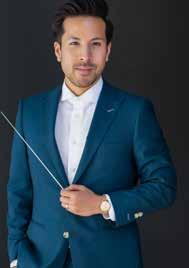
8 MuPhiEpsilon.org
Here’s your sneak peek at our exciting lineup. See you in Texas!
Mary Au and Rik Noyce
The 2023 Mu Phi Epsilon Convention will feature the best in educational programs and performances by collegiate and alumni members.
Francis Cathlina
SESSIONS
The Baker Sonata

Kristin Jonina Taylor (Alpha Kappa, Lincoln Alumni) performs a lecture-recital titled “The Baker Sonata: A Masterwork from a Legendary American Piano Professor.” Joanna Baker won the Mu Phi Epsilon Composition Competition with her sonata which she premiered at Carnegie Hall in 1954 on a live national radio broadcast. Baker served on the faculty of University of Missouri, Kansas City for 49 years. Jonina Taylor is an Icelandic-American pianist who has performed widely in the U.S. as well as throughout Europe. Jonina Taylor is a two-time Fulbright grant recipient and has released several professional recordings. She is an associate professor of piano and keyboard area coordinator at the University of Nebraska at Omaha. Jonina Taylor is a Steinway Artist and a member of the Steinway Teacher Hall of Fame.
Exploring the Archives
Two presentations will assist our members in preserving historical documents. “Saving Your Stuff,” best practices for archiving, will be the topic of Mu Phi’s international librarian and archives chair, Wendy Sistrunk (Mu Mu, Kansas City Alumni). Sistrunk recently retired as the music catalog librarian at the University of Missouri, Kansas City after over 25 years of service. Danielle
Kuntz (Mu Phi, Cleveland Alumni) presents “Mu Phi in the Archives.” Kuntz is associate professor of music history and Riemenschneider Bach Institute (RBI) Scholar-in-Residence at Baldwin Wallace University. She has served as the faculty adviser to the Mu Phi Epsilon chapter since 2017, and in 2020, she was named a Mu Phi Epsilon ACME Achievement Honoree.
Get That Money Honey!
Foundation Board members, Kira Dixon (Phi Mu, Palo Alto Alumni) and Zack Carlson-Giving (Zeta Lambda, Minneapolis Alumni) present “Get That Money Honey” about best practices in applying for Foundation grants and scholarships. Dixon has been the director of choirs at Christopher High School and South Valley Middle School in Gilroy, California, since 2016. Carlson-Giving is the vocal music director at Buffalo High School where he leads all curricular and extracurricular choirs, directs annual musicals and teaches Unified Music.
Effective Chapter Leadership
Tanner Wilson (Beta Alpha, Fullerton Alumni) shares his knowledge gained as a PSW1 District Director in “It Starts With You: Tips for Effective Chapter Leadership.” Wilson currently works as an academic advisor at San Diego State University, where he
SPRING 2023 I the triangle 9
One O’Clock Lab Band
helps students see their potential and aids them on the path to graduation. His inspiration to choose this as his profession came directly from supporting Mu Phi’s collegiate leadership. Wilson currently sings with the San Diego Master Chorale.
Generation
of 50
The 2023 Mu Phi Epsilon Convention promises to be a wonderful event filled with music, friendship, and harmony. We will see you there!
Alumni), executive director and conductor of the Inner City Youth Orchestra of Los Angeles, will hold a screening of “The House That Chuck Built.” The short independent film highlights Dickerson’s work with the predominantly Black youth orchestra, billed as the largest of its kind in the nation.
Po Sim Head (Omega Omega, Kansas City Alumni) will present “Generation of 50: The Peruvian Sounds in Francisco PulgarVidal’s Piano Works,” highlighting this lesser-known composer’s excellent repertoire for intermediate and advanced pianists interested in Latin American culture. Sim is a musicologistpianist and a passionate piano teacher. She is a regular presenter at national and local conferences such as Music Teachers National Association, Kansas Music Teacher Association and College Music Society. Sim is an adjunct instructor at Metropolitan Community College, Kansas City.
Applying Agile Methodology to Music
Wanda Yang Temko (Eta Eta, Atlanta Alumni) will present “Applying Agile Methodology to Music.” She will share how the Agile methodology used in software development has great potential for musicians including helping us stay organized in our creative work. Yang Temko is a respected singer, voice teacher and arts advocate. She is sought after as a recitalist and soloist and recently performed the role of Evangelist in David Lang’s Little Match Girl Passion with Kinnara. Yang Temko maintains an active private voice studio in Atlanta.
Seven Essentials for Developing Voices in Choir
Backed by historical literature and modern scientific studies, Francis Cathlina (Phi Tau, Dallas Alumni) presents tools to build the seven tenets of healthy vocal production: posture, breathing and support, tone, semi-occluded vocal tract exercises, laryngeal position, resonance, choral blend, the conductor’s model and gesture in his presentation “Seven Essentials for Developing Voices in Choir.” A Vietnamese-American conductor, Cathlina, serves as director of choral activities at the University of Memphis Rudi E. Scheidt School of Music. He guides a choral area of five ensembles, leads the doctoral and master’s choral conducting program and conducts the University Singers (SATB choir) and Mazi (SSAA choir). A 2023 Grammy quarterfinalist, Cathlina’s work has garnered national recognition at the university and high school levels.
“The House That Chuck Built”
Charles Dickerson (Omega Omega, Palos Verdes South Bay
And … More Music!
Featured throughout the Convention will be some of Mu Phi’s best collegiate and alumni professionals. Harold Rapp III (Omega Omega, Colorado Springs), saxophone, will play his own composition, Jungle Rain, for sax and digital production. Rapp is a multi-faceted artist whose music is featured on all major streaming platforms. Sarah Jordan (Mu Eta) will perform her composition Mystery and Fear for solo flute. Clarinetist Emily O’Brien (Phi Tau), will present Sonatina for Clarinet and Piano by Malcolm Arnold. Meg Gray (Beta Phi, Wichita Alumni) and Lynn Godfriax Maloy (Mu Kappa, Colorado Springs) team up for a performance of piano duets by Brahms. An excerpt from Claudia Jameson’s (Beta Kappa, Dallas Alumni) children’s opera Anam the Witch and Beatrice the Beautiful will be performed as a part of the Convention. Flutist Tiffany Ragan (Gamma Gamma, Oklahoma Alumni), will perform select movements from Pierre-Octave Ferroud’s Trois Pièces pour flûte seule. Singers Janelle Catbagan (Gamma Sigma, Palos Verdes/South Bay) and Jeremy Sarmiento (Gamma Sigma) perform selections including Sun and Moon from Miss Saigon with pianist Mary Au.

10 MuPhiEpsilon.org
HREGISTER NOW! H muphiepsilon.org/registration
Harold Rapp III
A BRILLIANT AFFAIR
Inaugural convention featured recital, trolley rides
u Phi Epsilon held its first annual national convention in 1904 at the Metropolitan College of Music in Cincinnati. The national convention was held every year, except 1918 due to the United States entering into World War I and 1921 during the outbreak of Spanish flu. The conventions became biennial at the 1922 convention in St. Louis. The first International Convention was held in 1964 after the Alpha Tau chapter at Philippines Women’s University was established. Triennial conventions have been held more or less since 1974. Prior to WW II, we must rely on convention reports printed in The Triangle. Separate printed programs for convention began appearing in 1946. The following secretary’s report was printed in The Triangle:
Mu Phi Epsilon Musical Sorority originated at Cincinnati, Ohio. Its founders were Elizabeth Mathias, vocal teacher in the Metropolitan College of Music, W.S. Sterling, dean of the college, and Calvin Vos, active member of Sinfonia and Phi Delta Theta fraternities.
Alpha chapter is located in the Metropolitan College of Music at Cincinnati, Ohio. It was installed November the thirteenth, 1903, with thirteen charter members.
Beta was organized on November 30, 1903, at the New England Conservatory of Music, Boston, Mass., with seven charter members.
Gamma was organized May the twentieth, 1904, with seven charter members, at the Univeristy School of Music, Ann Arbor, Michigan.
The first annual convention was held at Cincinnati, June 17, 18 and 19, 1904. Owing to lateness of date, Gamma was the only chapter represented by a delegate, in the person of Myrtal C. Palmer.

The forenoons of the three days of convention were given over to business meetings, Elizabeth Mathias acting as chairman. A constitution and by-laws were discussed and adopted. The convention closed, having elected the following officers:
President—Elizabeth Mathias, Cincinnati, Ohio.
Vice-president—Myrtal C. Palmer, Ann Arbor, Mich.
Secretary—Mary Towsley, Cincinnati, Ohio.
Treasurer—Alma Sterling, Cincinnati, Ohio.
Historian—Abigail M. Ely, Rutherford, New Jersey.
Social affairs in the way of trolley rides, a visit to the Rookwood Pottery and the Zoo made the time left from business pass rapidly. The convention recital was a brilliant affair musically and socially.
SPRING 2023 I the triangle 11
61GWENSINGER@GMAIL.COM FROM THE ARCHIVES
WENDY A. SISTRUNK, INTERNATIONAL LIBRARIAN AND ARCHIVES CHAIR, MU MU, KANSAS CITY ALUMNI
Myrtal C. Palmer was the sole delegate to attend the inaugural convention held in June 1904. Palmer served as the organization’s president from 1905 to 1907.

12 MuPhiEpsilon.org
JOSEPH LANGE: WOLFGANG AMADÉ MOZART AT THE PIANO, 1789, OIL PAINTING (UNFINISHED); COPYRIGHT: INTERNATIONALE SIFTUNG MOZARTEUM
MARY ROBBINS, MU THETA, AUSTIN ALUMNI
UNRAVELING A Mozart Mystery

n 2020, the International Mozarteum Foundation announced that a new manuscript by Mozart had been found, which is, of course, a rare occurrence! After Mozart’s musical handwriting had been verified by experts, a grand celebration was organized in Salzburg to present to the world his newly found Allegro in D Major, K. 626b/16. However, there were many questions surrounding it: no one could determine when he wrote it or where he was, since he didn’t write it on manuscript paper that could be traced — as by watermark, etc. — to its source. Rather, he wrote it on a scrap piece of paper on which he had to supply the lines, which today would be the equivalent of jotting a brilliant idea on a cocktail napkin. Also, Mozart wrote most of his works for specific events, but even very informed scholars couldn’t determine the purpose of this Allegro. Furthermore, even though he wrote it on the grand staff as a piano piece, in several ways it was not similar to his other piano works.

When the U.S. premiere of the Allegro was arranged for 2021, many questions concerning it remained unanswered. Several U.S. organizations, including The Society for Eighteenth-Century Music and The Mozart Society of America, proposed a joint symposium for the premiere to encourage more
research about the Allegro. Ulrich Leisinger, director of research at the International Mozarteum Foundation talked about how the piece was discovered. Uri Rom, a theorist at Tel Aviv University experienced in the dating of Mozart’s music, spoke about why Mozart could have composed the Allegro at a different time than had been tentatively proposed. I was honored to be invited to perform the Allegro, and to give a 10-minute talk that included why it might or might not be idiomatic for the keyboard.
The premiere began with the performance. The piece sounds a bit like Mozart, but certain things about it are very unusual. I addressed reasons for both in my comments, including certain places that made the Allegro awkward to play, but also how other places were almost identical to passages in later pieces, for example in his Sonata for Piano and Violin, K.376. My analysis was based on the particular sounds of notes that Mozart indicated in all of his music by expression markings. I am writing a book about this topic, which the Mu Phi Epsilon Foundation Liana K. Sandin Grant-in-Aid supported in 2019, so you are reading what Mu Phi helped make possible — although the book is now three books and still in progress.

SPRING 2023 I the triangle 13
Ulrich Leisinger
Uri Rom
Unknown complete composition first to be re-discovered in 80 years
My analysis led to several conclusions, including: the Allegro concerned action more than emotional expression and Mozart wrote it in a way to generate excitement that was similar to the Figaro overture. Certain features seemed to resemble a processional, such as fanfares usually played by brasses, while leaping intervals suggested human acrobatics of some kind. In short, it seemed to me that this music was more a sketch for a work to come at the beginning of an event, and that it was ultimately destined for other instruments, rather than for solo piano.
Imagine my surprise when Rom presented his conclusions that the Allegro was indeed written for action: it was a sketch of ballet music for dancers! I had never known that before every opera there was a ballet. Rom also identified that Mozart had heard the tune, which had been composed by another composer, and scribbled it down in a short-hand (piano) notation. Mozart later fleshed out this little sketch of the Allegro into ballet music for the orchestra to play, to bring the audience to their seats, settle them down and get them ready to listen to an opera overture. Rom had even found an orchestra recording of K.128, containing parts of the Allegro, at exactly the same tempo I had played, showing that our different approaches to considering Mozart’s music had led to a similar conclusion.
Finally, Leisinger presentation described a world connected with Mozart’s music that I had not been aware of, which attempts to trace the whereabouts of a work from the time Mozart composed it. In the case of the Allegro there were such questions as who first owned this manuscript (usually either Mozart’s wife, Constanza, their sons or his sister Maria Anna, nicknamed Nannerl, were the first owners), and how they came to either gift or sell Mozart’s manuscripts. From there, Leisinger discussed what happens to manuscripts when there are wars, including how they become lost and many other possibilities that gave me a new and deep respect for the work of monks, nuns and others connected with monasteries and convents. Mozart manuscripts have been hidden in Polish monasteries, then shuttled to French convents (or vice versa), only to languish in rooms unprotected from the elements, without glass panes in windows, much less electricity. This is an important part of the world of music, and those who love it might wish to find a way to support those who — with purest altruism — devote their lives to the survival of Mozart’s art as well as that of others.
Leisinger also discussed how the Allegro was assigned its K. (Köchel) number of K.626b/16 as a result of its being a work that doesn’t belong in usual categories, such as the category of opera, or concertos, etc. Such works go into one of two drawers, labeled “a” or “b,” and this Allegro is the sixteenth work to land in drawer b! It was a wonderful experience to play the Allegro as well as to participate in the mystery sleuth to learn how it is a part of Mozart’s musical world — and our musical world today.
The Mozart Family

Wolfgang Amadeus Mozart came from a very musical family. At a very early age, he and his sister received music tuition from their father, himself a composer. The family was considered well-to-do.
Mozart’s elder sister Maria Anna Mozart (1719-1787) was a talented pianist who could master even the most difficult of her brother’s compositions. She was in demand as a piano teacher in Salzburg, and as an adult she still performed in public concerts. Although her father and brother tried to encourage her, she composed only little, and regrettably, none of these pieces has survived.
Pianist Mary Robbins (Mu Theta, Austin Alumni) has spent much of her life studying and performing Mozart’s music. For 18 years she performed his works of all genres with piano as principal pianist for A Mozart Fest concert series. She is writing a book on how listeners and performers can connect with, as Mozart said, his music’s force and meaning through his unique system of expression. She has shared this view in The International Journal of Musicology and in presentations to the Mozart Society of America as well as through performances and workshops through support of the Music Teachers National Association and Steinway Piano Gallery of Austin, and has also received support from the Mu Phi Epsilon Foundation and the American Musicological Society. She spoke on Mozart’s cadenzas at the Mozart Bicentennial Congress in Salzburg, and has composed over thirty cadenzas and completions where Mozart’s are missing. She earned her DMA from the University of Texas at Austin.

14 MuPhiEpsilon.org
JOHANN NEPOMUK DELLA CROCE (C. 1780)
—International Mozarteum Foundation Salzburg
Wolfgang Amadeus Mozart with his sister, Maria Anna, and father, Leopold, on the wall a portrait of his dead mother, Anna Maria.
Discovery of the Allegro
Despite the large number of compositions that Wolfgang Amadeus Mozart wrote during his short lifetime, new discoveries are extremely rare. During the last decades, a few hitherto unknown original manuscripts by Mozart have come to light; these were, however, always incomplete pieces: sketches or drafts. It is more than 80 years ago that the re-discovery of an unknown complete composition in Mozart’s own handwriting was announced.
The Allegro in D major, K. 626b/16 fills the front and back of a single sheet of music paper in oblong format. The handwriting is hasty, but error-free. The undated composition stems in all likelihood from the first months of 1773, according to the Mozarteum Foundation; it thus originated either during Mozart’s third journey to Italy or immediately after his return to Salzburg. A trustworthy annotation of 1844 led to assume that the manuscript was once part of the estate of Mozart’s son, Franz Xaver Wolfgang. Franz Xaver, however, did not inherit it from his father, but rather from his aunt Maria Anna, Mozart’s sister, who apparently kept it as a memento. Peculiarities of style suggest that this three-part dance movement is not an original piano piece, but a keyboard arrangement in Mozart’s own hand of an unknown orchestral work.
Dr. Ulrich Leisinger, director of research of the Mozarteum Foundation, points out: “The Allegro in D major K. 626b/16 is a highly attractive and charming piano piece, that adds yet another facet to the affectionate relationship of Mozart to his sister. How wonderful, that we are now able to participate in this relationship after such a long period of time.”
—International Mozarteum Foundation Salzburg
Mozart’s Death
The entry in the coroner’s report by his personal physician Dr. Closset stated that Wolfgang Amadeus Mozart died on 5 December 1791 of “hitzigem Frieselfieber” [acute miliary fever]; this is not a precise medical diagnosis, but was in keeping with the official ordinance requiring a “brief notation of the manner of death” in the German language (i.e. not in Latin). For over 200 years, medical specialists have been attempting to determine the actual fatal illness, by means of contemporary accounts of the symptoms and the course of the disease (often written down much later) – with different results.

Also according to later reports, Mozart was consecrated in his coffin on 6 December 1791 at about 3:00 p.m. in front of the so-called Crucifix Chapel on the north side of St Stephen’s Cathedral. That same evening he was taken to St Marx cemetery, in a suburb of Vienna some 4 km away. An ordinance forbade mourners to follow the hearse beyond the town boundary.
Like many contemporaries of similar status, Mozart was given a third-class funeral, as entered in the register of deaths of the Cathedral Parish of St Stephen under 6 December 1791. The costs were fixed according to surplice fees. Mozart was buried in an unmarked shaft grave (usually a grave with four or five other bodies); this was common at the time, and was not (as sometimes asserted) a “pauper’s burial.”
St Marx Cemetery was closed in 1874 and is now a public park. The Mozart monument erected there in 1859 was moved in 1891 to the main cemetery (Zentralfriedhof) to join the group of Ehrengräber(graves of honour). Mozart’s grave in St Marx, a pilgrimage site for many visitors today, was later marked by a cemetery-keeper, who used materials left over from other graves, so that Mozart could be remembered at the abandoned site. It is located on the site of the former shaft graves.
—International Mozarteum Foundation Salzburg

SPRING 2023 I the triangle 15
HERMAN KAULBACH, 1873
INTERNATIONAL MOZARTEUM FOUNDATION SALZBURG
OLD WINE, NEW BOTTLES
The Lineage of Schoenberg’s Society for Private Musical Performances on Chamber Arranging Practices
hen the name Arnold Schoenberg (1874-1951) is mentioned in conversation, several associations come to mind: Second Viennese School, Expressionism Movement and Twelve-Tone Method However, few are aware of the composer’s work in forming an organization known as the Verein für musikalische Privataufführungen (Society for Private Musical Performances) in 1918 that centered on promoting modern music to select audiences within Vienna. While in their early stages they performed transcribed works for piano, eventually the Society began creating chamber arrangements from larger orchestra works such as Claude Debussy’s (1862-1918) Prélude à l’ après midi d’un faune, (Prelude to the Afternoon of the Faun), Max Reger’s (1873-1916) Eine romantische suite, (A Romantic Suite) and Gustav Mahler’s (1860-1911) Symphony No. 4.
The Society’s orchestration methodology for these works has created an interesting niche within orchestral chamber arrangements inspiring modern renditions of these practices from current artists, including British composer/arranger/performer Iain Farrington. In the early stages of the COVID-19 pandemic, such works were especially relevant to ensembles seeking to perform standard repertoire within the constraints of social distancing. This article seeks to create awareness of Schoenberg’s organization, highlighting how the arrangement methodology developed within it has created and given birth to new and exciting chamber arrangements today.
Schoenberg’s Verein was formed with several key goals in minds. These included the following:
1. Performances would feature modern music from Mahler onward, reflecting a composer’s “most engaging side.”
Repertoire would encompass “songs, piano pieces, chamber music, smaller choral works [and] orchestral works.”1
2. Works were to be rehearsed regularly and rigorously.2
3. Concerts would occur on a weekly basis, highlighted by the “frequent repetition” of pieces throughout the year and “introductory discussions of the works performed.” Concerts would be limited to select audience members only, with no “expressions of approval, or displeasure, and of gratitude” allowed.3 “Programs were never announced in advance.”4
4. Members could join at any time “one hour before each concert” and with a full year’s commitment. Dues were paid according to one’s financial means, with a total of seven classes to choose from.5
These carefully designed plans were spurred by a deep reverence and desire to present new music in a clearer way. This was not only achieved through multiple performances of a work and extensive rehearsals, but through the transcriptions and arrangements themselves. While mainly created to help lower concert costs, these orchestrations also helped to reveal the bare melodic, rhythmic and formal aspects of each work.
Upon further study of these arrangements, an interesting trend in orchestral methodology can be observed. Many of the chamber orchestral works created by the Verein were modeled from the instrumentation often found in salon orchestras popular during that time.6 This instrumentation generally included harmonium, piano, strings, select winds, and occasional percussion. Parts were usually prepared and performed by members within the Society, created through extensive rehearsals and score study.
16 MuPhiEpsilon.org
REBECCA NEDERHISER, BETA PI, LINCOLN ALUMNI
According to Walter Bailey, while no official documentation has been written on the Verein’s process for arranging, examining scores used by the Society have provided insight into their orchestration methods. One such score, Mahler’s Das Lied von der Erde, includes a page of instructions from Schoenberg listing the orchestration for the arrangement and his explanation for symbols used throughout the score.7
There are symbols to indicate passages to be played by the piano or harmonium, right or left hands. The piano symbol, indicated in red, consists of the letter K (for Klavier); to indicate a passage played by the right hand, a vertical stroke is added to the bottom of the right edge. A similar system is used for the harmonium, employing the letter H in green. The end of the passage for piano or harmonium is marked with a color-coded right-angle.8
Further instructions from Schoenberg on this page, give additional insight into his process of orchestration. Solo winds, and horn when included, were generally used to play the principal parts form the original score. However, if secondary/tertiary parts in a section needed to be performed by these soloists, a blue box, blue arrow, or additional directions would be indicated.9 Likewise, Schoenberg would cross out passages where the solo line was to be performed, and indicate a numeral for its replacement passage, usually located in the secondary/third parts of the section.10
Like winds, strings were generally kept on their original parts. When divisi occurred, Schoenberg often maintained the higher tessitura, reassigning the lower one as necessary. Brass lines and essential inner harmonies were given to the keyboard instrument and/or strings when available. Schoenberg would mark these
changes on his original score, by offsetting the passages with brackets and using abbreviations to indicate the instrument that was to perform them.11 While not all symbols and techniques were codified or exactly replicate in Schoenberg’s scores, similarities are observable and documented.12
Two of the five orchestral arrangements that were performed during the Verein’s existence were composed by Gustav Mahler. Following similar principles of Schoenberg’s orchestral methodology, in 1920 Erwin Stein began an arrangement of Mahler’s Symphony No. 4.13

While one of the larger arrangements completed within the Verein, Stein’s reconstructed version does follow similar orchestration trends of the Society. Scored for flute (dbl. piccolo), oboe (dbl. English horn), clarinet in A/Bb/C (dbl. bass clarinet), percussion (sleigh bells, suspended cymbal, glockenspiel, bass drum, tam-tam, triangle), harmonium, piano (4 hands), solo strings and soprano solo, Stein’s work attempts to mimic Mahler’s original core orchestration, with a few exceptions. In this, bassoon, horn, trumpet, timpani, and harp are eliminated from the scoring, adding in piano (4 hands) and a harmonium to fill out the missing lines/textures.
The arrangement reveals the following patterns, akin to trends observed throughout the Society’s oeuvre.
1. Principal winds are consistent with original scoring unless used to supplement additional melodies and/or harmonies. Optional parts are also included within the reconstruction, to be performed at the discretion of the conductor.

SPRING 2023 I the triangle 17
Trace Chamber Society. Rebecca Nederhiser, conductor (far left).
EMILIE BIEBER XUN XU
Gustav Mahler
2. Strings retain their original orchestration, unless used for doubling lines and/or melodies needed within the arrangement.
3. Keyboard instruments are treated with great versatility, often performing parts from the original winds, brass, strings, harp and occasionally percussion.
Stein’s arrangement of the Mahler was heard at three of the Verein concerts occurring on January 10, 20 and 23 in 1921.14


While the Society had extensive plans for additional arrangements, the organization faced bankruptcy the same year and was disbanded.
While the Society only lasted three short years, its legacy has lived on to inspire several composers, arrangers and organizations. One example is British composer/ arranger Iain Farrington whose publishing company, Aria Editions, hosts several chamber ensemble arrangements linked to Schoenberg’s original model. Internationally recognized, Farrington and his work have been featured on BBC Television, Classic FM and BBC Radio Three.
Farrington’s first encounter with the Verein arrangements occurred while performing Schoenberg’s version of Das Lied von der Erde at the Royal Academy of Music. This awareness grew into a fascination with the concept, but a desire to create chamber arrangements that were more authentic to the original score and allowed for easier access to performers and audiences.
Premiering on November 20, 2018, Farrington’s arrangement of Mahler’s Symphony No. 4 was commissioned by the Honourable Society of the Middle Temple in London for a performance by the Aurora Orchestra. Having performed the Stein/Platt arrangement on several occasions, Farrington sought to create a version that was closer to Mahler’s original orchestration and that eliminated barriers of performance. Thus, Farrington’s arrangement does not include keyboards (piano and harmonium) and only orchestrates parts for A and Bb clarinet, (no bass clarinet
and English horn), allowing for more portable instrument scenarios. Below is a chart comparing Farrington’s orchestration to that of the Stein/Platt.
Example 1: Stein and Farrington Orchestration Comparison for Mahler Symphony No. 4
Erwin Stein (1920-1921) Iain Farrington (2018)
1 flute (doubling piccolo) 1 flute (doubling piccolo)
1 oboe (doubling English horn) 1 oboe

1 clarinet in B-flat, C, and A 1 clarinet in A, B-flat (doubling bass clarinet)
1 bassoon
1 horn in F
1 trumpet in C
1 trombone
2 percussion: glockenspiel, 2 percussion: glockenspiel, triangle, cymbal, tam-tam, triangle, crash cymbal, tam-tam, sleigh bells, bass drum sleigh bells, timpani harmonium
2 pianos, 4 hands
Farrington’s orchestration more closely aligns to Mahler’s original, with key solos being replicated throughout the score. While Farrington’s approach to arranging is more flexible than the stricter orchestration methodology practiced within the Stein, a few principles can be observed:
1) Harp, bassoon, and trombone are scored to perform essential inner harmonies from the original score.
2) Flute is often used to double violin I (when not utilized to perform principal parts form the score or inner harmonies within the winds).
3) Winds are treated in a nimble manner, often sharing both solo and harmonic lines.
4) Strings, when not replicating their original scoring, perform original parts from the bass clarinet or contrabassoon lines and/or double melodies within their own section.
18 MuPhiEpsilon.org
A Society for Private Musical Performances announcement, c. 1919.
PHOTO CREDIT: ARNOLD SCHÖNBERG CENTER
Iain Farrington
RICHARD GERSTL
Arnold Schoenberg
The following are a few examples of Farrington’s arrangement principles.
Rebecca Nederhiser (Beta Pi, Lincoln Alumni) is a passionate conductor, scholar and music educator. She currently serves as the conductor of the Wartburg Community Symphony and the Kammerstreicher string ensemble and teaches music theory, oboe and conducting at Wartburg College in Waverly, Iowa, where she is an assistant professor of music.

Known for her collaborative spirit, Nederhiser has created unique orchestral experiences for performers and audiences alike. In 2019, she led performances of Schoenberg’s Pierrot Lunaire leading to the formation of the ensemble, the Trace Chamber Society (TCS). Performance highlights from TCS have included Janáček’s The Cunning Little Vixen (arr. by Iain Farrington) and Copland’s Appalachian Spring: Suite for 13 Instruments
In her short time at Wartburg College, Nederhiser has created community engaging traditions including an inaugural Meistersinger Chamber String Camp, the formation of the St. George String Quartet and collaborations with national composers and artists. Nederhiser earned master degrees from Washington State University (oboe performance), Central Washington University (orchestral conducting) and her DMA in orchestral conducting from the University of Nebraska-Lincoln.
1 Judith Meibach, “Society for Private Musical Performances: Antecedents and Foundations,” Journal of the Arnold Schoenberg Institute 8, no. 2 (November 1984), 164.
2, 3 Meibach, 165.
4 Meibach, 172.
5 Meibach, 168.
6 Walter B. Bailey, “The Chamber-Ensemble Arrangements of the Orchestral Songs, Opus 8: Realizing Schoenberg’s Instructions to his Students,” Journal of the Arnold Schoenberg Institute 13, no. 1 (June 1990): 64.

7 Bailey, 68
The year 2021 marked the 100 anniversary premier of Erwin Stein’s Symphony No. 4 by the Society. In addition to Iain Farrington’s Aria Editions Publishing, the Verein influenced several additional organizations: The International Composers Guild (1921), The Prague Society for Musical Private Performance (1922), The International Society for Contemporary Music (1922), League of Composers: New York (1923), Marlboro Music Festival (1950) and Les Grands Concerts de la Sorbonne (1961).15 In Judith Meibach’s words:
“A measure of all artistic achievement is the degree of its influence on future developments. There can be no doubt that the Society for Musical Private Performances made a lasting impact on the evolution and diffusion of modern music. The Verein enabled succeeding generations to benefit from Schoenberg’s pivotal experiments in the education of a motivated public toward a deeper understanding of modern music.”16
8, 9, 10, 11 Bailey, 69
12 See score examples in Bailey’s “The Chamber-Ensemble Arrangements of the Orchestral Songs, Opus 8.”

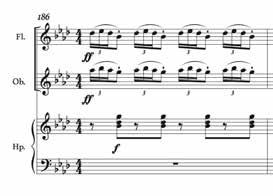
13 Since the original score of the Stein arrangement was lost, in 1990 the Britten Estate and Marion Thorpe (née Stein) commissioned Alexander Platt to reconstruct the work from an annotated score marked by Stein. Three years later, the work was published under Josef Weinberger, premiering in the following months at Wigmore Hall (London). While there are some objections to the pure realization of the work, the reconstruction does provide a tangible depiction of Stein’s creative process and design.
14 Jerry McBride, “Orchestral Transcriptions for the Society for Private Musical Performances,” Journal of the Arnold Schoenberg Institute 7, no. 1 (June 1983): 116.

15 Judith Meibach, “Schoenberg’s Society for Musical Private Performances,’ Vienna 1918-1922: A Documentary Study,” 210.
16 Meibach, 109.
SPRING 2023 I the triangle 19
Example 2: Mahler Symphony No. 4, Mvt. I m. 186
Example 2.1: Mahler Symphony No. 4, Mvt. I m. 186 Arr. by Farrington
Example 3: Mahler Symphony No. 4, Mvt. I m. 69
Example 3.1: Maher Symphony No. 4, Mvt. I mm. 69-70 Arr. by Farrington
The National Association of Teachers of Singing announced in October that Barbara Hill Moore (Mu Chi), senior associate dean for faculty and Meadows Foundation Distinguished Professor of Voice at Southern Methodist University Meadows School of the Arts, established the Barbara Hill Moore Award for Emerging Teaching Artists. Through a generous challenge grant, Hill Moore seeks to establish an endowment to support a biennial award to facilitate professional development of a NATS teacher of singing who is also pursuing an active performance career.

Tiffany (Piper) Ragan (Gamma Gamma, Oklahoma Alumni) received the 2023 Young Music Educator Award at the Oklahoma Music Educators Association conference in January. The award is given to up and coming music educators around the state who have shown excellent teaching and musical growth in their programs and have no more than five years of teaching experience.

APPLAUSE & ENCORE
International President
Kurt-Alexander Zeller (Mu Chi, Atlanta Alumni),
who is a licensed body mapping educator, visited Missouri State University in Springfield, Missouri, in November where he was the guest clinician for the fall meeting of the Ozark Chapter of the National Association of Teachers of Singing.

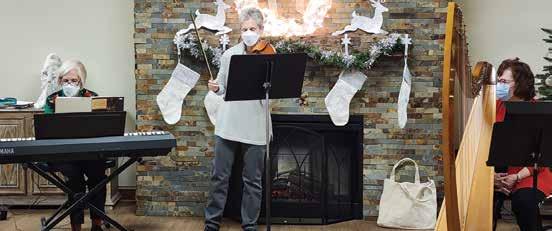
Members of the Colorado Springs Alumni chapter performed a December concert at the Daughters of the American Revolution Holiday Tea event.

During its March gathering, the Atlanta Alumni chapter enjoyed a gorgeous recital by Clayton State University Delta Psi chapter’s faculty advisor and soprano, Francisca Maxwell (Delta Psi, second from left) and pianist Elena Dorozhkina (far left). Jean Astrop (Mu Phi, Atlanta Alumni, third from right) hosted the meeting in her home.

20 MuPhiEpsilon.org
In December, the Indianapolis Alumni chapter held its annual performance for residents of Rosegate senior community. Pictured from left: Cathy Radomski (Kappa, Indianapolis Alumni), Betsy Levin (Alpha Beta, Indianapolis Alumni) and Kim Coplen (Kappa, Indianapolis Alumni).
MEMBER AND CHAPTER NEWS
The Boston Alumni chapter recently awarded the Patricia Callan Mu Phi Epsilon Music Grant to Little Sister Sara of the Big Sister Boston program. The grant provides Sara, a junior at Boston Arts Academy pictured at right with her Big Sister Kayla, with nine onehour private voice lessons.

Ruth Bures (Omega) recently released a children’s book titled I’m So Glad There’s Someone. The positive and uplifting story contains a template for health communication about feelings.

Regina Tanujaya (Alpha Kappa, Kansas City Alumni) and Matteo Generani (Alpha Kappa) co-founded the Neo-Art Piano Duo in 2022. In February, they were invited as guest artists for a 10-day residency performing numerous concerts for Emerald Coast Music Alliance Foundation. The duo performs programs of audience favorites and their own four-hands arrangements.

Dorothy Brandwein (Gamma, Kansas City Alumni) presented a program, “G, Let’s Listen to some R&B,” during the Kansas City Alumni chapter’s March meeting.
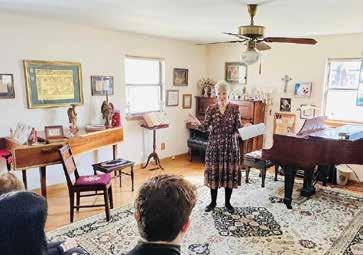

SPRING 2023 I the triangle 21
Alpha Kappa chapter at the University of Missouri, Kansas City, performed a holiday concert for residents of Kingswood Senior Living Community in Kansas City in mid-December.
The National Association for Music Education Northwest Division awarded Cam McCarrey Bohman (Epsilon Mu) the 2023 Distinguished Service Award in recognition of her 55-plus years in the field of music education. She is the music coordinator for the Alaska School Activities Association.

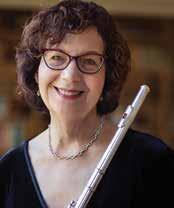

Mu Phi Epsilon was well-represented at the Northwest Division Conference of the National Association for Music Education held in Washington in February. Several members presented or conducted at the conference including Brandon Nelson (Phi Tau) and Jerilynn Harris (Epsilon Sigma).


LET US CLAP FOR YOU!
Send your newsworthy member and chapter news to editor@muphiepsilon.org for consideration in Applause & Encore. Please include a sharp, high-resolution photo and include any identifying information, including the place, date, event or award, and name(s).
22 MuPhiEpsilon.org
Mu Phi Epsilon had a strong showing at the Texas Music Education Association conference held in San Antonio, Texas, in February. The South Central Province chapters of Mu Phi Epsilon met for their annual Sing Along and social Thursday evening led by Rachel Reed (Alpha Pi).
APPLAUSE & ENCORE MEMBER AND CHAPTER NEWS
Susan Greenberg (Phi Nu, Los Angeles), artistic director of Chamber Music Palisades, performed a concert with the renowned Pacific Trio in March.
JOIN US IN WELCOMING NEW COLLEGIATE MEMBERS!


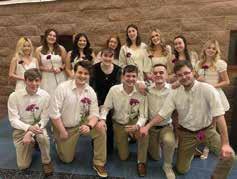
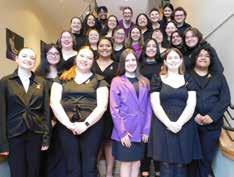
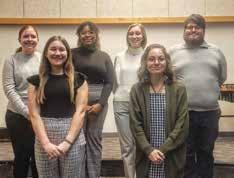

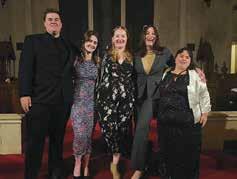
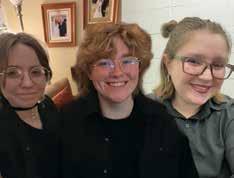
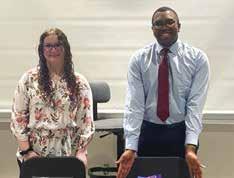

SPRING 2023 I the triangle 23 MFE
Gamma Sigma, California State UniversityDominguez Hills
Gamma Zeta, Delta State University, Cleveland, Mississippi
Kappa, Butler University in Indianapolis, Indiana
Mu Eta, University of the Pacific in Stockton, California
Phi, University of Mount Union in Alliance, Ohio
Phi Omega, Westminster College in New Wilmington, Pennsylvania
Alpha Omega, Stephen F. Austin State University in Nacogdoches, Texas
Epsilon Epsilon, Texas Christian University in Fort Worth, TexasIndiana
Phi Mu, San Jose State University in San Jose, California
Phi Tau, University of North Texas in Denton, Texas
ATLANTIC DISTRICT A1
Stephanie Berry 574.596.8285
bmpenguin69@hotmail.com
DISTRICT A2
Susan Todenhoft
703.323.4772 H 703.509.0224 C todenhoft@gmail.com
EASTERN GREAT LAKES
DISTRICTS EGL1 & EGL2
Hannah Flowers 814.897.6531 mrs.hannah.flowers@gmail.com
DISTRICT EGL3
Nancy Jane Gray 330.688.7990 bobgrayz@aol.com
GREAT LAKES
DISTRICT GL1
Pat Butler 734.751.9069
liv2sail2@aol.com
DISTRICT GL2
Linda McNair 314.494.7472
c1dd@muphiepsilon.org
EAST CENTRAL DISTRICTS EC1
Herbert Jackson 678.577.3637 herbertjackson5@gmail.com
DISTRICTS EC2 & EC3
Brandon Barnett 317.557.3443
indianapolis@muphiepsilon.org
SOUTHEAST DISTRICT SE1
Marshall Pugh 252.599.2492 se1dd@muphiepsilon.org
DISTRICTS SE2
Wanda Yang Temko 404.217.9712 wanda@yangtemko.com
DISTRICTS SE3
Arietha Lockhart 404.284.7811 ariethal@hotmail.com
DISTRICT SE4
Marcus Wyche 301.484.3652 videoauth@aol.com
SOUTH CENTRAL DISTRICTS SC1, SC3 & SC4 Isabel De La Cerda idelacerda@hotmail.com 210.204.6425
DISTRICT SC2
Kaitlyn Swaim 281.757.9746 swaimk00@gmail.com
CENTRAL DISTRICT C1
Linda McNair 314.494.7472 c1dd@muphiepsilon.org
DISTRICT C2
Paula Patterson 417.773.1176
paulapatterson@missouristate.edu
NORTH CENTRAL DISTRICT NC
Carmen Chavez 952.460-0708
nc1dd@muphiepsilon.org
WEST CENTRAL DISTRICT WC1
Ashley Roever 580.822.5682
amroever@hotmail.com
DISTRICT WC2
Kirsten Forbes 720.232.6450
kirsten_forbes@msn.com
PACIFIC NORTHWEST DISTRICT PNW1
Sophia Tegart 509.991.4906
sophia.tegart@gmail.com
DISTRICTS PNW2 & PNW3
Michael Lasfetto 971.275.3800
pnw3dd@muphiepsilon.org
PACIFIC DISTRICT P1
Jessica Dodge Overstreet 775.720.2135
jessicadodge@gmail.com
DISTRICT P2
Kirsten Forbes 720.232.6450
kristen_forbes@msb.com
PACIFIC SOUTHWEST DISTRICT PSW
Ayanna Lewis 310.970.4462
psw1dd@muphiepsilon.org
Tanner Wilson 951.515.9680
tannerwilson263@gmail.com
24
MuPhiEpsilon.org DISTRICT DIRECTORY
2021-2024 INTERNATIONAL EXECUTIVE BOARD
Dr. Kurt-Alexander Zeller, Mu Chi Atlanta Alumni
International President 770.961.4400 president@muphiepsilon.org
Liana Sandin, Beta Pi Lincoln Alumni
1st VP/Extension Officer 402.560.7126 extensionofficer@muphiepsilon.org
Ashley Bouras, Phi Tau Dallas Alumni
2nd VP/Collegiate Advisor 972.765.3252 collegiateadvisor@muphiepsilon.org
Ann Geiler, Phi Theta St. Louis Alumni
3rd VP/Alumni Advisor 314.691.7648 alumniadvisor@muphiepsilon.org
Dr. Rebecca Sorley, Kappa Indianapolis Alumni
4th VP/Music Advisor 317.885.1103 musicadvisor@muphiepsilon.org
Terrel Kent, Esq., Beta Zeta Baton Rouge Alumni
5th VP/Eligibility Advisor 225.772.7384 eligibilityadvisor@muphiepsilon.org
Jess LaNore, Beta Psi Indianapolis Alumni Executive Secretary-Treasurer 888.259.1471 executiveoffice@muphiepsilon.org
Kat Braz International Editor editor@muphiepsilon.org
HONORARY ADVISORY BOARD
Rosemary Ames, Omega Boston Alumni
508.498.4669 rosemarykames@gmail.com
Katherine Doepke, Phi Beta Minneapolis Alumni 763.513.0381 katdoepke@gmail.com
Lee Clements Meyer, Phi Xi Austin Alumni 512.345.5072
SOCIAL MEDIA
Haley Stevenson, Kappa Indianapolis Alumni social@muphiepsilon.org
MUSIC LIBRARIAN & ARCHIVES
Wendy Sistrunk, Mu Mu Kansas City Alumni 816.309.5910 61gwensinger@gmail.com
INTERNATIONAL CHAIRMEN ACME
Arietha Lockhart (Chair) Beta Gamma, Atlanta Alumni 404.284.7811 ariethal@hotmail.com
Mary Au (Co-Chair), Mu Nu Los Angeles Alumni 323.666.2603 auhaus@gmail.com
BYLAWS & STANDING RULES
Dr. Kurt-Alexander Zeller, Mu Chi Atlanta Alumni 770.961.4400 zellertenor@aol.com
FINANCE
Evelyn Archer, Omega Omega St. Louis Area Alumni 458.562.9177 archerbe@sbcglobal.net
INTERNATIONAL
Marlon Daniel, Mu Xi New York City Alumni 212.641.0305 marlondanielnyc@gmail.com
2022-2023 FOUNDATION BOARD
Zachariah Carlson-Giving, President Zeta Lambda, Minneapolis Alumni president@mpefoundation.org
Dr. Matthew Hoch, Vice President Lambda vicepresident@mpefoundation.org
Dr. Katsuya Yuasa, Secretary Phi Mu secretary@mpefoundation.org
Sean Kilgore, Treasurer Kappa treasurer@mpefoundation.org
Isabel De La Cerda, Delta Omega San Antonio Alumni admin@mpefoundation.org
Kira Dixon, Artist Concert Manager Grants and Scholarship Chairman Phi Mu, Palo Alto Alumni grants@mpefoundation.org
Dr. Kurt-Alexander Zeller Mu Chi, Atlanta Alumni president@muphiepsilon.org
SPRING 2023 I the triangle 25
DIRECTORY
OFFICER’S
Mu Phi Epsilon Professional Music Fraternity
6510 Telecom Drive, Suite 200 Indianapolis, IN 46278
executiveoffice@muphiepsilon.org
888-259-1471
PROTECTING OUR VALUES. SUPPORTING OUR PROGRAMMING. PROVIDING QUALITY PRODUCTS.
When you purchase from a licensed vendor, you are assured a quality product at a competitive price — with a portion of the proceeds directly benefiting the programming and guidance offered by Mu Phi Epsilon.
For Mu Phi Epsilon merchandise, visit greeklicensing.com




 PRESIDENT, MU CHI, ATLANTA ALUMNI PRESIDENT@MUPHIEPSILON.ORG
PRESIDENT, MU CHI, ATLANTA ALUMNI PRESIDENT@MUPHIEPSILON.ORG






























































